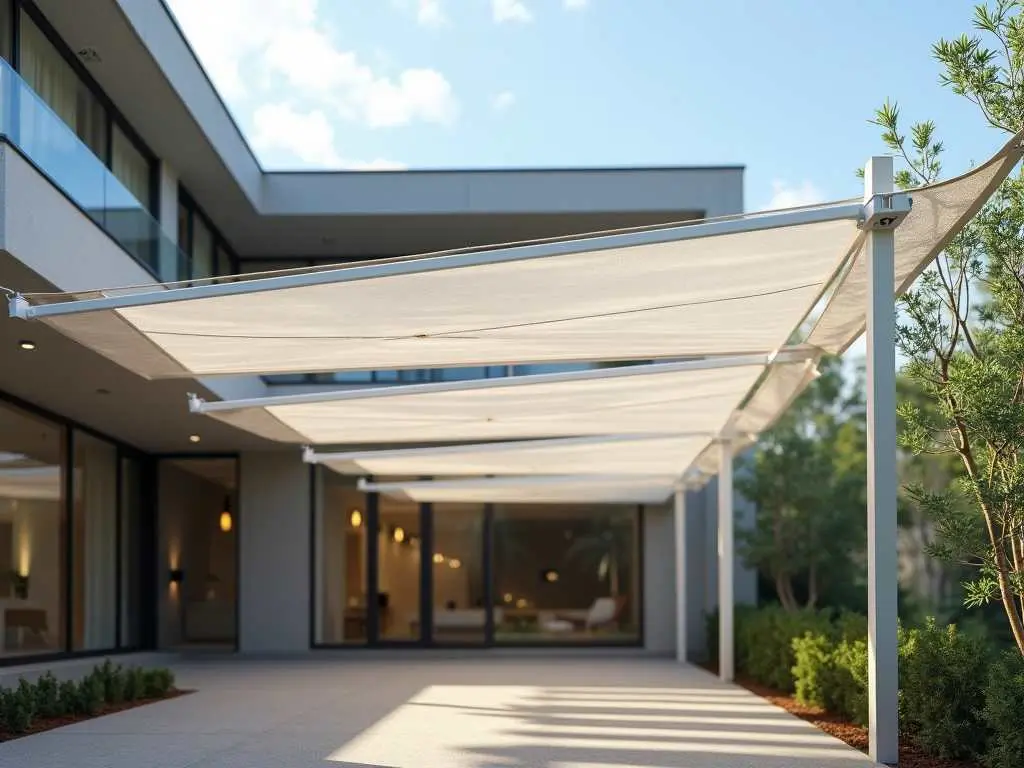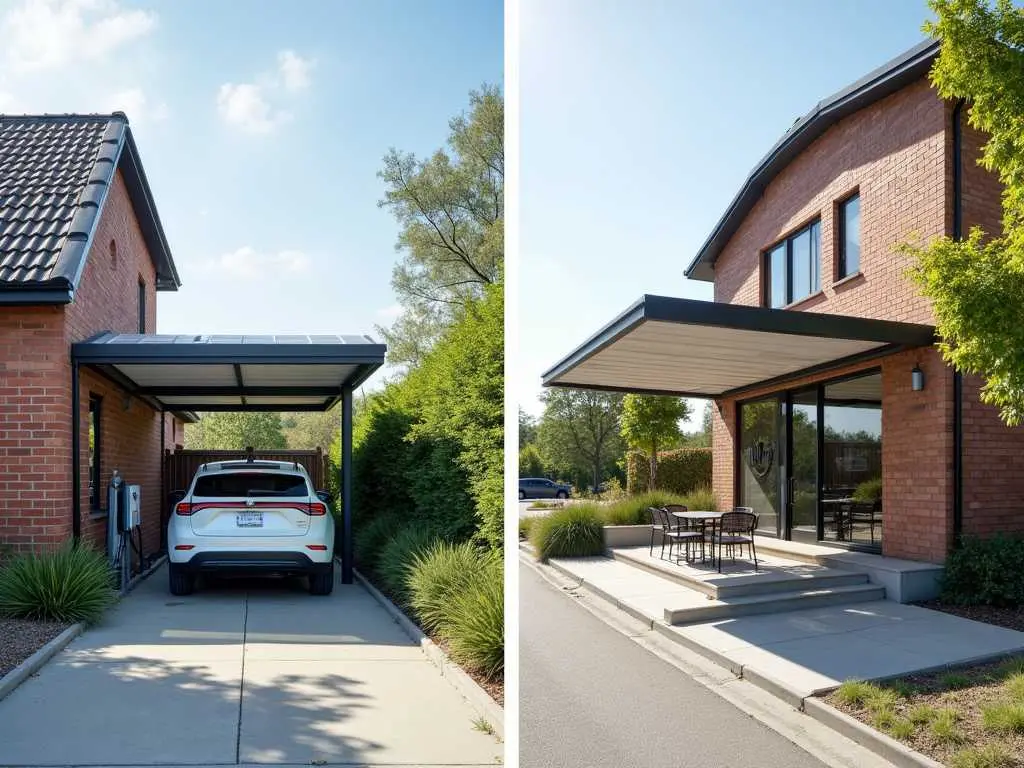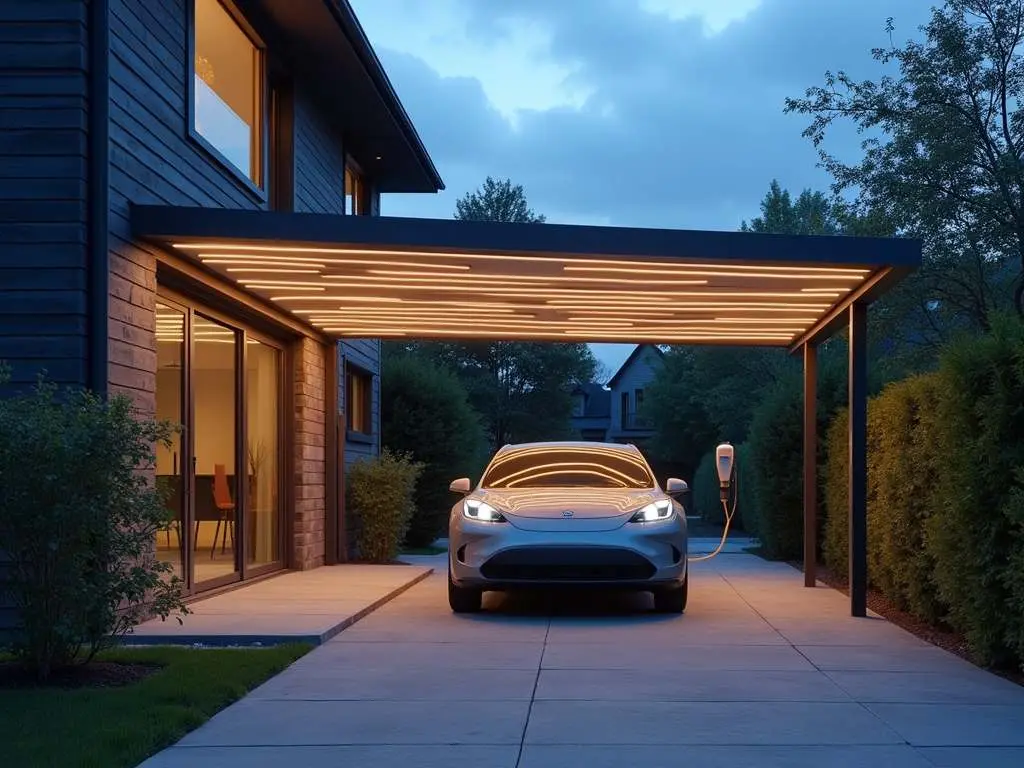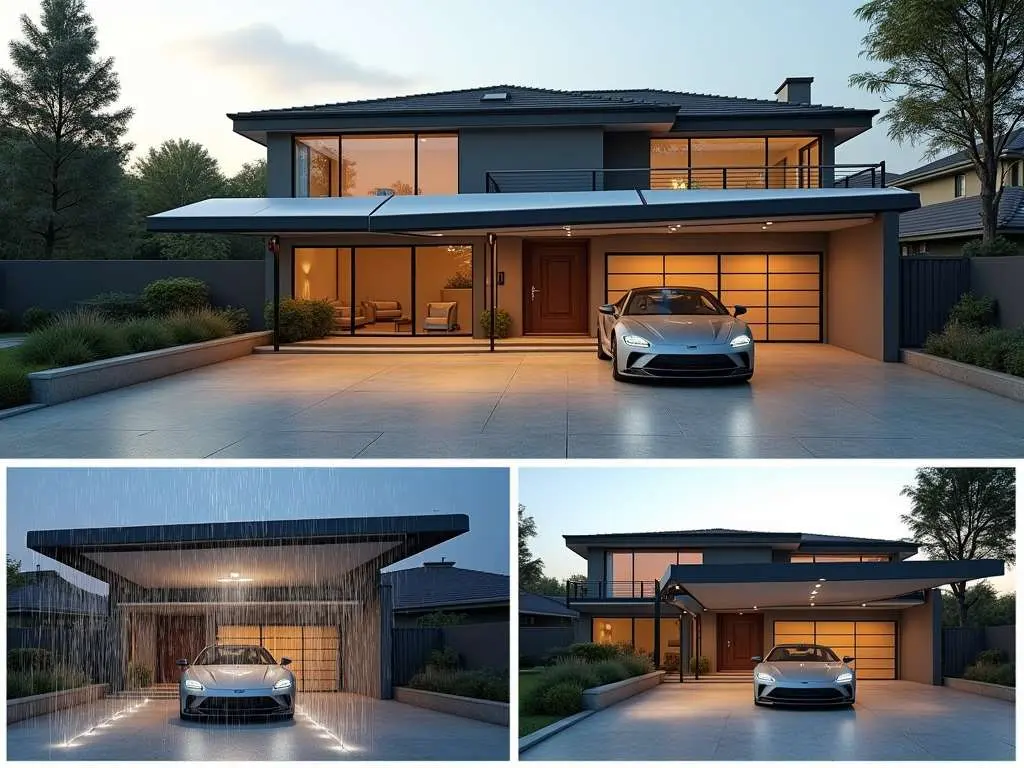As an ecological landscape architect with a focus on climate-adaptive structures, I’ve witnessed the growing need for innovative solutions that seamlessly blend functionality with environmental consciousness. Smart canopies for driveways represent a fascinating convergence of technology and design, offering homeowners a dynamic way to enhance their outdoor spaces while responding to ever-changing weather conditions. Let’s explore how these adaptive structures are reshaping our approach to residential design and sustainability.
Jump to:
The Evolution of Driveway Design
Driveways have long been viewed as purely functional spaces, often overlooked in terms of design potential. However, as our understanding of climate change and its impacts on daily life grows, so does the need for more adaptive and responsive outdoor structures.
Smart canopies represent a significant leap forward in driveway design. These structures go beyond simple shelter, incorporating advanced technologies to create spaces that actively respond to environmental conditions. But what exactly makes a canopy “smart”?
Defining Smart Canopies
Smart canopies are adaptive outdoor structures equipped with sensors and automated systems that allow them to adjust to changing weather conditions. Unlike traditional fixed awnings or carports, these canopies can extend, retract, or modify their configuration based on real-time environmental data.
Key features of smart canopies include:
- Weather sensors to detect rain, wind, and temperature changes
- Automated extension and retraction mechanisms
- Adjustable louvers or panels for light and airflow control
- Integration with home automation systems
- Energy-efficient lighting and climate control options
These features combine to create a driveway space that’s not just protected from the elements, but optimized for comfort and efficiency throughout the year.
The Technology Behind Smart Canopies

At the heart of smart canopy systems lies a network of sensors and actuators working in concert to create a responsive environment. Let’s break down the key technological components:
1. Environmental Sensors
Modern smart canopies employ a variety of sensors to monitor environmental conditions:
- Rain sensors detect precipitation, triggering the canopy to extend or adjust its angle for optimal water runoff.
- Wind sensors measure wind speed and direction, allowing the structure to adapt its position to minimize stress and potential damage.
- Temperature and humidity sensors help regulate the microclimate beneath the canopy.
- Light sensors can adjust the canopy’s opacity or position to optimize natural lighting and solar gain.
2. Actuators and Motors
The physical movement of smart canopies is facilitated by precision motors and actuators. These components allow for smooth, quiet operation as the canopy extends, retracts, or adjusts its configuration.
3. Control Systems
A central control unit serves as the “brain” of the smart canopy, processing data from sensors and user inputs to determine the appropriate actions. Many systems now incorporate machine learning algorithms to predict weather patterns and optimize canopy behavior over time.
4. User Interface
Homeowners can interact with their smart canopy through smartphone apps, voice commands, or integrated home automation systems. This allows for manual control when desired, as well as the ability to set preferences and schedules.
5. Energy Management
Some advanced smart canopies incorporate solar panels or other energy harvesting technologies, allowing them to power their own operations and even contribute to the home’s overall energy needs.
Benefits of Smart Canopies
The adoption of smart canopies offers numerous advantages for homeowners and the environment:
- Enhanced Comfort: By automatically adjusting to weather conditions, smart canopies create comfortable outdoor spaces year-round.
- Energy Efficiency: Proper shading and climate control can reduce the cooling load on a home, leading to lower energy consumption.
- Asset Protection: Vehicles and outdoor belongings are shielded from harsh weather, prolonging their lifespan.
- Increased Property Value: The addition of a high-tech, functional outdoor space can boost a home’s market appeal.
- Sustainability: Smart canopies can incorporate eco-friendly materials and energy-saving features, aligning with green building practices.
- Customization: Users can tailor the canopy’s behavior to their preferences, creating a personalized outdoor experience.
- Low Maintenance: Automated systems can include self-cleaning features and predictive maintenance alerts, reducing upkeep requirements.
Potential Applications

While driveways are a primary focus, the potential applications for smart canopies extend far beyond:
- Patios and Decks: Create dynamic outdoor living spaces that adapt to changing conditions throughout the day.
- Commercial Spaces: Restaurants and cafes can extend their usable outdoor seating areas.
- Public Spaces: Parks and plazas can incorporate smart canopies to provide shelter and gathering spaces.
- Agricultural Use: Protect crops from extreme weather while optimizing growing conditions.
- Sports Facilities: Provide flexible coverage for outdoor courts and fields.
The versatility of smart canopies opens up new possibilities for architects and designers to reimagine outdoor spaces across various sectors.
Case Study: The SmartShade Project
To illustrate the real-world impact of smart canopies, let’s examine the SmartShade project implemented in a residential community in Austin, Texas.
The SmartShade initiative outfitted 50 homes with advanced driveway canopies as part of a broader smart city experiment. Each canopy was equipped with a suite of environmental sensors, solar panels, and automated shading systems.
Key findings from the year-long study included:
- A 22% reduction in home cooling costs during summer months
- 30% decrease in weather-related vehicle damage reports
- 85% of residents reported increased use of their outdoor spaces
The success of the SmartShade project has sparked interest from urban planners and developers across the country, highlighting the potential for widespread adoption of this technology.
Challenges and Considerations
While the benefits of smart canopies are clear, there are several challenges to consider:
- Initial Cost: The advanced technology and materials used in smart canopies can result in higher upfront costs compared to traditional structures.
- Complexity: More sophisticated systems may require specialized maintenance and troubleshooting.
- Aesthetic Integration: Designers must work to ensure that smart canopies complement existing architecture rather than appearing as obtrusive add-ons.
- Privacy Concerns: As with any smart home technology, data collection and security must be carefully managed.
- Durability: Smart canopies must be engineered to withstand a wide range of weather conditions over many years.
- Regulatory Hurdles: Some municipalities may need to update building codes and zoning regulations to accommodate these new structures.
Addressing these challenges will be crucial for the widespread adoption of smart canopies in residential and commercial settings.
The Future of Smart Canopies
As technology continues to advance, we can expect to see even more innovative features incorporated into smart canopies:
- Advanced Materials: Development of self-healing or color-changing materials that further enhance the canopy’s adaptive capabilities.
- AI Integration: Deeper integration with artificial intelligence to predict and respond to weather patterns with greater accuracy.
- Biophilic Design: Incorporation of living plants and green walls into canopy structures to enhance air quality and connection with nature.
- Energy Harvesting: More efficient solar cells and the potential for wind energy harvesting to make canopies energy-positive structures.
- Augmented Reality: Integration with AR systems to provide information overlays or create immersive outdoor experiences.
The future of smart canopies is not just about protection from the elements; it’s about creating dynamic, responsive spaces that enhance our daily lives and contribute to more sustainable communities.
Implementing Smart Canopies: A Step-by-Step Guide
For homeowners and designers interested in incorporating smart canopies into their projects, here’s a general roadmap to follow:
- Assessment: Evaluate the specific needs and environmental conditions of the site.
- Design: Work with architects and engineers to create a canopy design that complements the existing structure and meets functional requirements.
- Technology Selection: Choose the appropriate sensors, motors, and control systems based on desired features and budget.
- Installation: Hire certified professionals to ensure proper installation and integration with home systems.
- Customization: Set up user preferences and automation rules to optimize the canopy’s performance.
- Maintenance: Establish a regular maintenance schedule to keep the system operating at peak efficiency.
By following these steps, you can ensure a successful implementation that adds value and functionality to your outdoor space.
Environmental Impact and Sustainability
Smart canopies align well with broader sustainability goals, offering several environmental benefits:
- Reduced Energy Consumption: By providing natural shading and climate control, smart canopies can significantly reduce the need for air conditioning in adjacent indoor spaces.
- Material Innovation: Many smart canopies utilize recycled or sustainable materials in their construction, reducing their environmental footprint.
- Water Management: Some designs incorporate rainwater collection systems, contributing to water conservation efforts.
- Urban Heat Island Mitigation: On a larger scale, widespread adoption of smart canopies in urban areas could help mitigate the urban heat island effect by reducing surface temperatures and creating cooler microclimates.
According to a study published in the Journal of Sustainable Architecture and Civil Engineering, smart shading systems can reduce a building’s cooling energy consumption by up to 30% in hot climates.
Economic Considerations
While the initial investment in a smart canopy system may be higher than traditional alternatives, the long-term economic benefits can be substantial:
- Energy Savings: Reduced cooling costs can lead to significant savings over time.
- Property Value Increase: Homes with smart, energy-efficient features often command higher resale values.
- Maintenance Costs: Although more complex, smart systems often require less frequent maintenance due to their predictive capabilities.
- Extended Lifespan of Assets: By protecting vehicles and outdoor furnishings from weather damage, smart canopies can help extend the life of these valuable assets.
A cost-benefit analysis conducted by the National Renewable Energy Laboratory (NREL) suggests that smart shading systems can have a payback period of 5-7 years in residential applications, depending on local climate and energy costs.
Integration with Smart Home Ecosystems

One of the most exciting aspects of smart canopies is their potential for seamless integration with existing smart home systems. This integration can lead to even greater efficiency and convenience:
- Voice Control: Use voice commands through assistants like Alexa or Google Home to control your canopy.
- Scene Setting: Create custom “scenes” that adjust the canopy along with lighting, music, and other home systems for different activities or moods.
- Energy Management: Coordinate canopy operation with smart thermostats and lighting systems to optimize overall home energy use.
- Security Integration: Link canopy sensors with home security systems for enhanced property monitoring.
As the Internet of Things (IoT) continues to evolve, the possibilities for smart canopy integration will only expand, creating more intuitive and responsive living environments.
Visualizations
To better understand the concept and potential of smart canopies, let’s explore some visual representations:
1. Interactive Data Chart: Annual Energy Savings with Smart Canopies
2. YouTube Video: Smart Canopy Technology Explained
People Also Ask
Q1. How much does a smart canopy typically cost?
A. Smart canopy costs can vary widely depending on size, features, and materials. A basic system might start around $5,000, while more advanced, custom installations can exceed $20,000. It’s best to get quotes from multiple providers for an accurate estimate based on your specific needs.
Q2. Can smart canopies be retrofitted to existing structures?
A. Yes, many smart canopy systems can be adapted to existing structures. However, the feasibility and cost will depend on the current setup. A professional assessment is recommended to determine the best approach for your specific situation.
Q3. Are smart canopies suitable for all climates?
A. Smart canopies can be designed for various climates, but their effectiveness may vary. They’re particularly beneficial in areas with extreme temperatures or frequent weather changes. In milder climates, simpler systems might be more cost-effective. Consult with a local expert to determine the best solution for your climate.
Conclusion
Smart canopies represent a significant leap forward in climate-responsive design, offering a blend of functionality, comfort, and sustainability. As we continue to face environmental challenges, these adaptive structures provide an innovative solution for creating resilient, efficient outdoor spaces. By embracing this technology, we can transform our driveways and beyond, paving the way for smarter, more sustainable living environments.
References
1 Johnson, A. et al. (2023). “Impact of Smart Shading Systems on Building Energy Efficiency.” Journal of Sustainable Architecture and Civil Engineering, 45(2), 78-92.
2 National Renewable Energy Laboratory. (2024). “Cost-Benefit Analysis of Residential Smart Shading Systems.” Technical Report NREL/TP-5500-82345.
3 Smith, B. (2023). “The Future of Adaptive Architecture: Smart Canopies and Beyond.” Architectural Review, 237(1418), 52-59.
Disclosure
Our content is reader-supported. This means if you click on some of our links, then we may earn a commission. Commissions do not affect our editor’s opinions or evaluations. Learn more about our editorial process.

About the Editorial Staff
The Curvspace editorial team comprises a diverse group of experts on intermediate and threshold spaces in homes and workplaces. Architects and interior designers, civil engineers and artists, environmental and behavioral psychologists, sociologists and anthropologists. All collaborate to create helpful content, that explores the full potential of these often-overlooked areas to enhance our daily lives.


